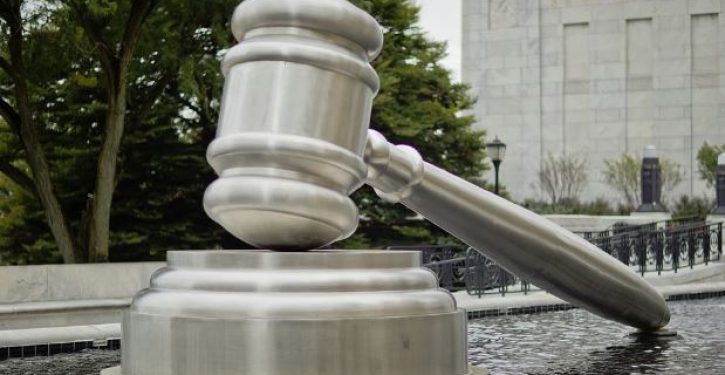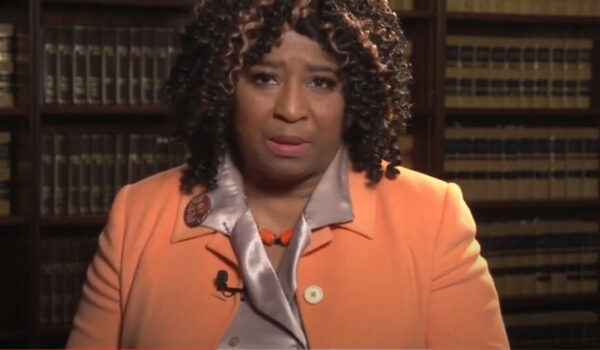
Joe Biden is selecting judges based in large part on race and gender, even though that’s unconstitutional. The White House boasts that of his 140 judicial nominees, 62% are people of color and 62% are women. His judicial nominees have been 31% Black, 18% Asian American and 18% Hispanic. These percentages are far higher than the percentage of the legal profession that is black, female, or persons of color. Only 5% of lawyers are black, while 76% of lawyers are non-Hispanic whites. This reflects the fact that most Americans are white, and only 13.6% of the U.S. population is black. The people qualified to be federal judges are experienced lawyers who have litigated in the federal courts. Such experienced lawyers are predominantly white and male. Only about 40% of all lawyers are female, and among experienced, full-time attorneys (such as law firm partners), the percentage is significantly lower than 40%. Even among the experienced Democratic lawyers one would expect Biden to pick judges from, a majority are white and a majority are male.
The Constitution forbids racial and sexual discrimination by federal officials, even against whites and males, according to the Supreme Court’s rulings in Adarand Constructors v. Pena (2000) and Sessions v. Morales-Santana (2017). But Biden is unlikely to face any legal consequences for this, such as being sued, even though he is violating the Constitution by doing this, and thus violating his oath of office. Presidents have absolute civil immunity against being sued for money damages, few people would have clear legal standing to sue over it (probably only alternative judicial nominees), and few of them would dare bring a lawsuit against Biden over it.
Statistical disparities don’t necessary show discrimination. But they can show discrimination when the disparity is large, and the statistics take into account relevant qualifications, such as comparing the racial percentage of those selected versus the racial percentage of the qualified applicant pool. For example, in Students for Fair Admissions v. President and Fellows of Harvard College (2023), the Supreme Court found that Harvard College had engaged in illegal racial discrimination against whites and Asians, and in favor of blacks and Hispanics, based heavily on the fact that applicants’ odds of admission varied greatly based on their race.
The percentage of judges Biden has nominated who are white or male (38%) is far lower than their percentage of the qualified labor pool — experienced lawyers who practice in federal court — the vast majority of whom are white, and most of whom are male. This racial and gender disparity is not only large, but also legally relevant, because it takes into account relevant qualifications, and reflects a large number of nominations (140), not just a few isolated decisions. The racial disparity seems statistically significant even if you define the qualified applicant pool in every conceivable way that maximizes the percentage of minorities in it (such as including only Democratic lawyers as potential judges, not independents or Republicans who are more likely to be white, and including relatively junior lawyers who include more minorities, rather than just senior, experienced lawyers who are more heavily white).
Moreover, Biden has openly boasted that he uses race and gender in judicial selection. For example, he specifically promised to appoint a black woman to the Supreme Court — and then did so, even though the Supreme Court already had a black justice (and even though his black appointee had far less judicial experience than other potential Supreme Court picks who were Asian, Hispanic, or Caucasian). Biden has similarly pledged to reshape the federal judiciary’s demographics.
The combination of large, meaningful statistical disparities with Biden’s openly using race in judicial selection demonstrates that Biden is engaging in a pattern or practice of discrimination. The Supreme Court found a pattern or practice of discrimination in Teamsters v. United States, when statistics showed blacks and Hispanics being hired at a much lower rate than their percentage of the relevant labor pool, and there were some specific examples of racial discrimination against blacks and Hispanics. That Supreme Court decision demonstrates that what Biden is doing is unconstitutional, unless he has a compelling reason for using race in judicial selection. But Biden has no compelling, or even legitimate, reason to use race in judicial appointments.
The Supreme Court allows minorities to be given a racial preference in hiring to remedy recent, widespread, intentional racial discrimination against them by the government. (See Richmond v. J.A. Croson Co. (1989); Vitolo v. Guzman (2021)).
But Blacks have not been discriminated against in judicial appointments in recent years, and actually are overrepresented on the federal bench.”As of February 20, 2023, 25 (15%) of 170 active circuit court judges are African American (of whom 13 are men and 12 are women),” notes a CRS Report. As former Justice Department lawyer Ed Whelan noted in 2021, when there were far fewer blacks on the bench, “black men are overrepresented in the federal judiciary: They account for 7.9 percent of active federal judges but only 6.8 percent of the population.”
Black men are even more overrepresented compared to their share of the legal profession. The black percentage of the legal profession is a much more logical benchmark for assessing “underrepresentation” than the black percentage of the population, because judges need legal experience to do their job competently, so it is the legal profession’s demographics that potentially matter, not the general population’s. According to “the American Bar Association’s 2020 Profile of the Legal Profession….85.9 percent of American lawyers are white, 4.7 percent are African American, 4.6 percent are Hispanic, and 2.1 percent are Asian American.” While whites back in 2020 “account[ed] for 85.9 percent of lawyers,” they accounted for “only 72 percent of active federal judges,” making whites underrepresented on the bench.
“Meanwhile, African Americans are overrepresented by a factor of nearly three: They make up 12.7 percent of active federal judges while accounting for only 4.8 percent of lawyers,” said Whelan back in June 2021, when there were fewer blacks on the bench. “Hispanics are doubly overrepresented: 9 percent of active federal judges versus 4.6 percent of lawyers. Ditto for Asian Americans: 4.7 percent of active federal judges versus 2.1 percent of lawyers,” notes Whelan.
Blacks are overrepresented on the Supreme Court. There are two black Supreme Court justices comprising 22% of the Supreme Court, and there has been a black Supreme Court justice ever since 1967 — even though blacks have never been more than 14% of the U.S. population during that period, and blacks have usually comprised less than 3% of the legal profession during that period. (It is the black percentage of the legal profession, not the black percentage of the general population, that is legally relevant in assessing whether blacks are “underrepresented” in the judiciary, according to Supreme Court rulings like Wards Cove Packing Co. v. Atonio (1989)).
The fact that blacks and women may have been largely barred from the legal profession in the 19th Century doesn’t justify giving them a racial preference today. Racial set-asides can’t be used to remedy discrimination that occurred long ago. Federal appeals courts have struck down racial preferences designed to remedy governmental discrimination that happened 14 or 17 years earlier, saying that such discrimination in the distant past is irrelevant. (See Brunet v. Columbus (1993); Hammon v. Barry (1987)). So there is no justifiable reason for race-based judicial appointments.
There also is no reason to give women a preference in judicial selection. The female percentage of federal judges — 39.29% as of 2021 — was higher than the percentage of experienced lawyers who are women (for example, law firm partners are about 36% female in 2023, and the percentage was lower back in 2021), and similar to the percentage of lawyers who are women (40%). So women are not underrepresented compared to what merit-based selection would yield.
Nor is there any “diversity” justification for using race or gender in federal judicial selection. The Supreme Court effectively rejected the diversity rationale for using race in its recent decision in Students for Fair Admissions v. President and Fellows of Harvard College (2023). But even courts that allowed race or gender to be used to promote “diversity” did not allow it to be used to promote proportional representation. The judge who came up with the “diversity” rationale for using race, Justice Lewis Powell, said that proportional representation was a patently invalid reason for using race, a principle that the Supreme Court has reiterated over and over again. (See, e.g., Parents Involved in Community Schools v. Seattle School District (2007))).
Prior to Biden’s judicial nominations, the federal judiciary already qualified as “diverse.” Diversity” does not require that an institution be mostly non-white, or mostly non-male. Court rulings have found institutions to be diverse even when their demographics diverge more from the population they serve than does the federal judiciary. Boston has a mostly minority student population, but a court ruled Boston could not use race in admissions to increase the percentage of blacks and Hispanics at a selective school, because colorblind admissions would already yielded enough diversity: a student body that was over 15% black and Hispanic. As the Boston-based federal appeals court explained, diversity was already present where “under a strict merit-selection approach, black and Hispanic students together would comprise between 15% and 20% of each entering class, and minorities, in toto, would comprise a substantially greater percentage.” (Wessmann v. Gittens (1998)).
Institutions are not supposed to use race in hiring, to make their staff reflect the racial composition of the population they serve. For example, a federal appeals court ruled that a city could not consider race in promotions to make its police department better reflect “the racial composition of the city” or “remedy racial imbalances in the police department.” That violated the Constitution’s Fourteenth Amendment. (See Police Association of New Orleans v. City of New Orleans, 100 F.3d 1159, 1169 (5th Cir. 1996)).
The Supreme Court ruled that schools cannot make employment decisions based on race, in order to provide minority students with “role models” of their own race. (See Wygant v. Jackson Board of Education (1986)).
Employers usually cannot discriminate based on race — even against white people. The Supreme Court ruled that firing white employees based on their race violated two federal laws, in its decision in McDonald v. Santa Fe Trail Transportation Co. (1976).
Above, I suggested that potential judicial nominees are probably the only people who who have standing to sue over Biden’s use of race in judicial selection. Note, however, that the Supreme Court has ruled that litigants can challenge discrimination in jury selection. (See Powers v. Ohio (1991)).



